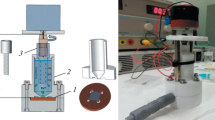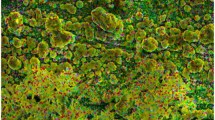Abstract
A thin coating of thorium on aluminium substrates with the areal density of 110 to 130 μg/cm2 is developed over a circular area of 22 mm diameter by using the electrodeposition method. An electrodeposition system is fabricated to consist of three components; an anode made of a platinum mesh, a cylindrical-shape vessel to contain the thorium solution, and a cathode in the form of a circular aluminium plate. The aluminium plate is mounted horizontally, and the platinum mesh is connected to an axial rod of an electric motor, mounted vertically and normal to the plane of the aluminium. The electrolyte solution is prepared by dissolving a known-weight thorium nitrate powder in 0.8 M HNO3 and isopropanol. The system is operated either in constant voltage (CV) or constant current (CC) mode. Under the electric field between the anode and cathode, thorium ions were deposited on the aluminium substrate mounted on the cathode. In the CV mode at 320, 360, and 400 V and in the CC mode at 15 mA, thorium films were formed over a circular area of the aluminium substrate. The areal density of thorium coating was measured by detecting emitted alpha particles. The areal density of thorium varied from 80 to 130 μg/cm2 by changing the deposition time from 10 to 60 min. The results from the CV mode and CC mode are compared, and the radial dependence in the measured areal density is discussed for different modes of the electric field. The developed thorium coatings are to be used in the in-house development of particle detectors, fast neutron converters, targets for thorium fission experiments, and other purposes.





Similar content being viewed by others
References
B.H. Kang et al., ISOL facility for rare isotope beams at RAON. J. Korean Phys. Soc. (2013). https://doi.org/10.3938/jkps.63.1473
S. Jeong, P. Papakonstantinou, H. Ishiyama, Y. Kim, A Brief Overview of RAON Physics. J. Korean Phys. Soc. 73, 4 (2018)
Y.J. Kim, Current status of experimental facilities at RAON. Nucl. Instrum. Methods Phys. Res. Sect. B (2020). https://doi.org/10.1016/j.nimb.2019.04.041
Y. Chung, H. Kim, M. Kwon, Current status of the RAON low-energy heavy ion accelerator. J. Korean Phys. Soc. 80, 8 (2022)
S. Andriamonje et al., Experimental studies of a Micromegas neutron detector. Nucl. Instrum. Methods Phys. Res. Sect. A 481, 1–3 (2002)
R. Beyer et al., Characterization of the neutron beam at nELBE. Nucl. Instrum. Methods Phys. Res. Sect. A 723, 151–162 (2013)
C. Akers et al., Large area PPAC development at the rare isotope science project. Nucl. Instrum. Methods Phys. Res. Sect. A 910, 49–53 (2018)
D.Y. Kim et al., Development of the MICROMEGAS detector for measuring the energy spectrum of alpha particles by using a 241 Am source. J. Korean Phys. Soc. (2016). https://doi.org/10.3938/jkps.68.1060
C. Ham et al., A Simulation Study and Its Experimental Validation for the Detection of Neutrons with a Continuous Energy Spectrum by Using a MICROMEGAS Detector. J. Korean Phys. Soc. (2019). https://doi.org/10.3938/jkps.75.775
S. Andriamonje et al., Development and performance of Microbulk Micromegas detectors. J. Instrum. 5, 02 (2010)
P. Rodriguez, C.V. Sundaram, Nuclear and materials aspects of the thorium fuel cycle. J. Nucl. Mater. 100, 1 (1981)
D. Heuer et al., Towards the thorium fuel cycle with molten salt fast reactors. Ann. Nucl. Energy (2014). https://doi.org/10.1016/j.anucene.2013.08.002
U.E. Humphrey, M.U. Khandaker, Viability of thorium-based nuclear fuel cycle for the next generation nuclear reactor: issues and prospects. Renewable Sustain. Energy Rev. 97, 259–275 (2018)
M.C. Duijvestijn et al., Proton-induced fission at 190 MeV of nat W, 197 Au, nat Pb, 208 Pb, and 232 Th. Phys. Rev. C 59, 2 (1999)
I.V. Ryzhov et al., Fragment-mass distributions in neutron-induced fission of Th 232 and U 238 at 33, 45, and 60 MeV. Phys. Rev. C 83, 5 (2011)
D. Tarrio, Neutron-induced fission fragment angular distribution at CERN n TOF: The Th-232 case. 2012, Ph.D. Thesis, University of Santiago de Compostela
G. Sibbens et al., in AIP Conference Proceedings. (2018)
C. Ingelbrecht, A. Moens, R. Eykens, A. Dean, Improved electrodeposited actinide layers. Nucl. Instrum. Methods Phys. Res., Sect. A 397, 1 (1997)
Y. He et al., Molecular plating of actinide compounds on wafer-scale aluminum substrate. J. Alloys Compd. (2021). https://doi.org/10.1016/j.jallcom.2021.160393
G. Sibbens et al., Preparation of 240Pu and 242Pu targets to improve cross-section measurements for advanced reactors and fuel cycles. J. Radioanal. Nucl. Chem. 299, 2 (2014)
G. Sibbens, A. Moens, D. Vanleeuw, D. Lewis, and Y. Aregbe, in EPJ Web of Conferences. EDP Sciences (2017)
D. Roman, The electrodeposition of thorium in natural materials for alpha spectrometry. J. Radioanal. Nucl. Chem. 60, 2 (1980)
L. Hallstadius, A method for the electrodeposition of actinides. Nucl. Instrum. Methods Phys. Res. 223, 2–3 (1984)
L.C. Hao et al., Rapid preparation of uranium and thorium alpha sources by electroplating technique. Kerntechnik 75, 6 (2010)
W.S. Aaron, M. Petek, L.A. Zevenbergen, J.R. Gibson, Development and preparation of thin, supported targets and stripper foils. Nucl. Instrum. Methods Phys. Res., Sect. A 282, 1 (1989)
V. Jobbágy et al., Preparation of high-resolution 238U α-sources by electrodeposition: a comprehensive study. J. Radioanal. Nucl. Chem. 298, 1 (2013)
J.C. Harduin, B. Peleau, D. Levavasseur, Détermination analytique des actinides dans les milieux biologiques. Radioprotection 31, 2 (1996)
S. Srivastava et al., Concentration and activity ratio of thorium isotopes in surface soil around proposed uranium mining site in India. Radiat. Prot. Environ. 36, 3 (2013)
J. Strišovská, J. Kuruc, D. Galanda, Ľ Mátel, Surface’s weights of electrodeposited thorium samples determined by alpha spectrometry. J. Radioanal. Nucl. Chem. 288, 2 (2011)
M. Hakamada, T. Kuromura, Y. Chen, H. Kusuda, M. Mabuchi, Influence of porosity and pore size on electrical resistivity of porous aluminum produced by spacer method. Mater. Trans. 48, 1 (2007)
Acknowledgements
This work was supported in part by the National Research Foundation of Korea (NRF) funded by the Ministry of Science and ICT (Grant nos. NRF-2013M7A1A1075764, NRF-2015H1D3A1066285, NRF-2016R1D1A1B03935429, NRF-2018M2A8A2083829, NRF-2019R111A1A01060797, and NRF-2020R1A2C1102384).
Author information
Authors and Affiliations
Corresponding author
Additional information
Publisher's Note
Springer Nature remains neutral with regard to jurisdictional claims in published maps and institutional affiliations.
Rights and permissions
Springer Nature or its licensor (e.g. a society or other partner) holds exclusive rights to this article under a publishing agreement with the author(s) or other rightsholder(s); author self-archiving of the accepted manuscript version of this article is solely governed by the terms of such publishing agreement and applicable law.
About this article
Cite this article
Moon, DH., Chavan, V., Bhoraskar, V. et al. Development and characterization of thorium coatings by using an electrodeposition system and alpha spectroscopy. J. Korean Phys. Soc. 82, 1040–1046 (2023). https://doi.org/10.1007/s40042-023-00826-6
Received:
Revised:
Accepted:
Published:
Issue Date:
DOI: https://doi.org/10.1007/s40042-023-00826-6




